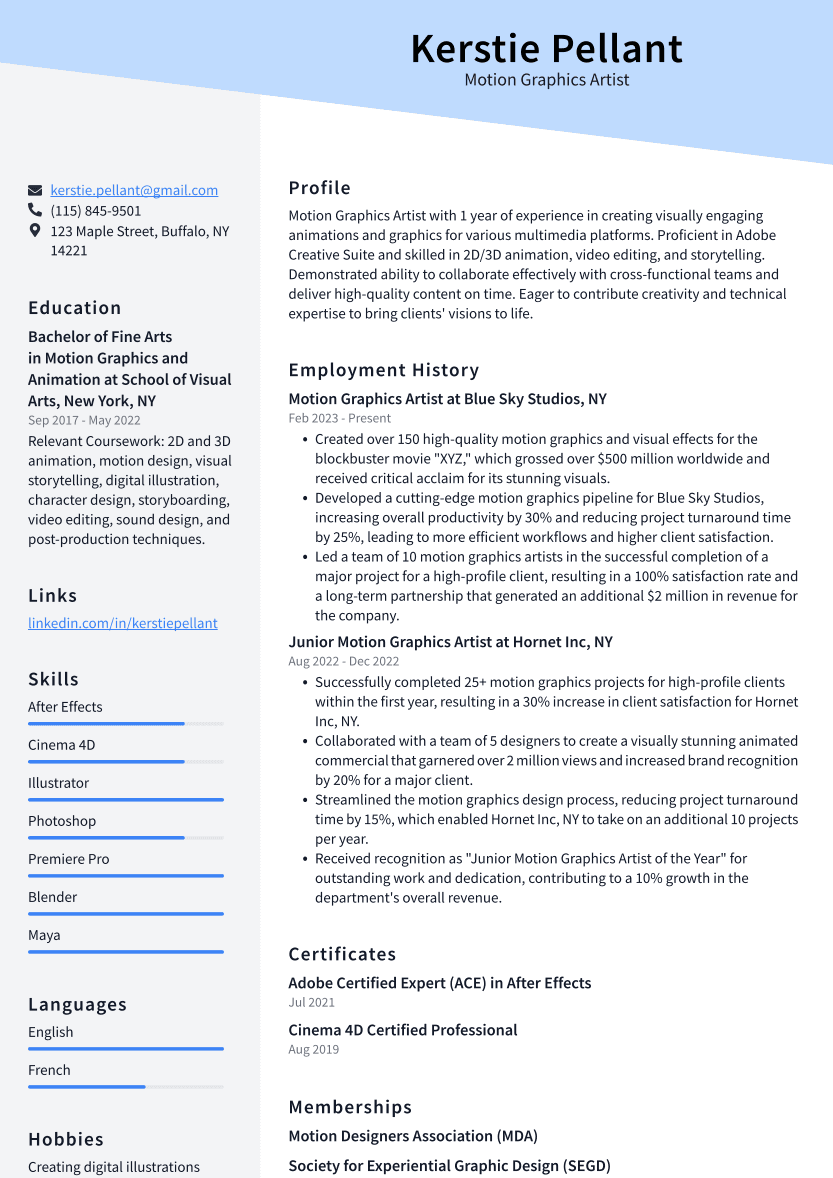Motion Graphics Artist Resume Examples
Writing a great motion graphics artist resume is important because it is one of the first things a potential employer will see when they are considering you for a position. It is your opportunity to make a good first impression and sell yourself as the best candidate for the job.
Create your resume
Select from 7 professional resume templates
If you're looking for inspiration when it comes to drafting your own motion graphics artist resume, look no further than the samples below. These resumes will help you highlight your experience and qualifications in the most effective way possible, giving you the best chance of landing the motion graphics artist job you're after.
Essential Components for a Motion Graphics Artist's Resume
For a Motion Graphics Artist, a resume is more than a summary of work history—it's a portfolio in prose and a testament to your creative prowess. It should not only detail your experience and education but also highlight your mastery of design software and your capacity for crafting compelling visual narratives.
While it includes standard sections like personal details, employment history, and educational background, it also emphasizes technical skills, a portfolio showcase, and software proficiency.
Let's explore the key sections of a Motion Graphics Artist Resume, their significance, and how to optimize them to capture the attention of potential employers.
1. Contact Information
Your Contact Information must be prominent and complete, including your name, phone number, email, and a LinkedIn profile if available. It's the conduit through which opportunities find you, so accuracy and currency are paramount.

Consider adding links to your digital portfolio or professional websites, but omit sensitive personal data. Ensure your email address is professional, ideally incorporating your name.
Recruiters often start with this section, so it should be flawless and easy to find.
2. Professional Summary or Objective Statement
A compelling Professional Summary or Objective Statement at the top of your resume can shape the hiring manager's first impression. It should succinctly encapsulate your career highlights, skills, and aspirations.
Emphasize your industry experience, notable projects or clients, software expertise, and unique talents such as 3D animation or interactive design.
For those newer to the field, an Objective Statement should outline your career goals and how you intend to contribute to a prospective employer's success.
Customize this statement for each application to align with the job description, showing that you've done your homework.
Related: Top Motion Graphics Artist Resume Objective Examples
3. Skills and Proficiencies
The Skills and Proficiencies section is where you list your technical and creative capabilities. Include software proficiency (Adobe After Effects, Cinema 4D, etc.), animation skills, creativity, attention to detail, problem-solving, time management, communication, and adaptability.
These skills should be evident in your portfolio and job descriptions, demonstrating your practical application of these abilities.
Related: Motion Graphics Artist Skills: Definition and Examples
4. Work Experience and Achievements
Detail your career path in reverse chronological order, emphasizing tasks and achievements that showcase your motion graphics expertise. Include quantifiable successes and mention freelance or internship experiences that demonstrate relevant skills.
Highlight experiences pertinent to the job you're seeking, focusing on transferable skills from non-related positions.
Include significant academic or volunteer work that demonstrates your abilities as a Motion Graphics Artist.
5. Portfolio or Sample Works
Your portfolio is a visual testament to your skills and should feature a diverse array of projects. Include descriptions that clarify your role and contributions, especially for collaborative works.
An online portfolio is indispensable in the digital era, showcasing your technical savvy alongside your creative work.
Focus on quality over quantity and keep your portfolio current with your latest and greatest projects.
6. Education and Certifications
List your educational background, emphasizing degrees relevant to motion graphics. Highlight certifications and continuous learning efforts, such as online courses or workshops, and include internships or training programs that provided hands-on experience.
Present these qualifications in reverse chronological order, along with the institutions where they were obtained.
Related: Motion Graphics Artist Certifications
7. References
References should be individuals who can attest to your skills and work ethic. Obtain their consent and inform them about the job you're applying for so they can provide relevant endorsements.
It's standard to prepare a separate document for references rather than listing them on your resume, with the phrase "References available upon request" signaling their availability.
Choose references who can effectively speak to your qualifications as a Motion Graphics Artist.
By focusing on these key elements and tailoring your resume to each job application, you'll present a compelling narrative of your skills and experiences, positioning yourself as a standout candidate in the field of motion graphics.